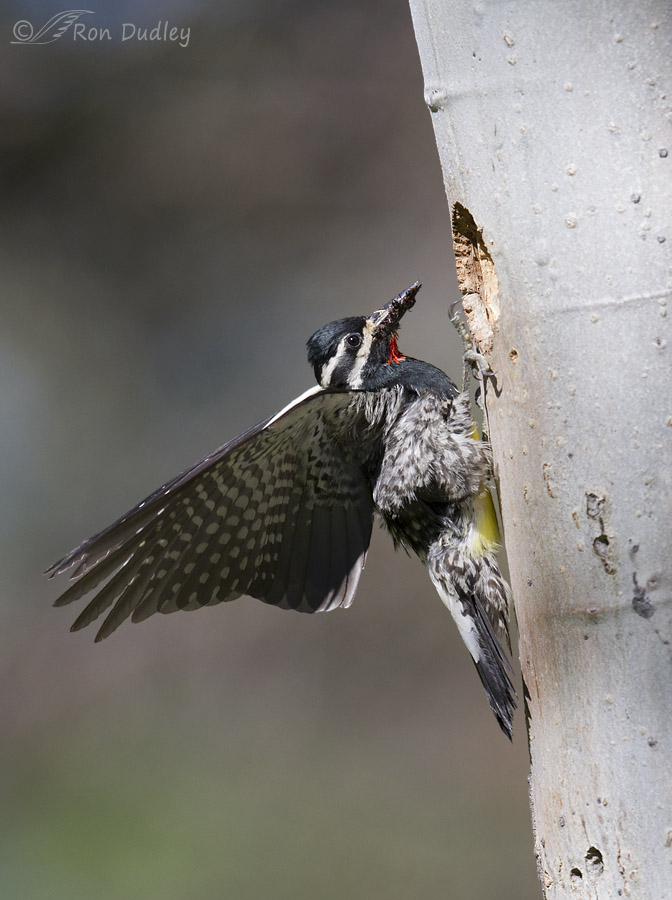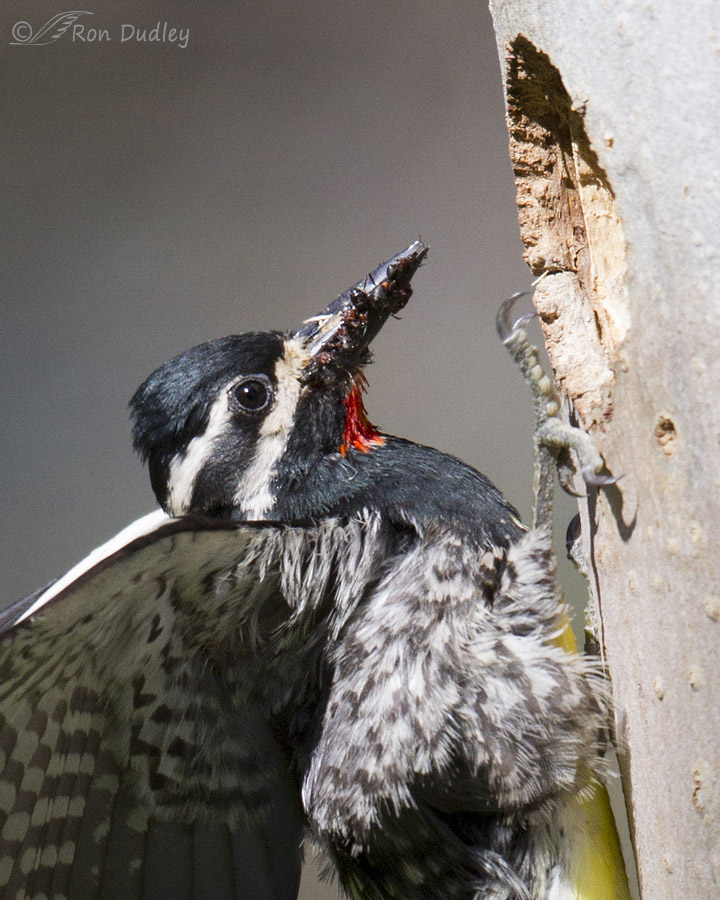I sure do miss this woodpecker and its mate. I photographed them for parts of two breeding seasons in Clark County, Idaho but about a month ago some idiot chopped down their nest tree (the one in these images) and I haven’t seen the birds since.
 1/2500, f/5. ISO 640, Canon 7D, Canon EF500mm f/4L IS II USM, not baited, set up or called in
1/2500, f/5. ISO 640, Canon 7D, Canon EF500mm f/4L IS II USM, not baited, set up or called in
Here the male had just landed at the nest cavity with a beak-full of ants for its chicks in the nest. The tree was within a campsite in a National Forest so the birds were used to the hubbub of campers and went about their business with no sign of disturbance as I photographed them from my truck with a long lens (we camped elsewhere because there was no cell signal here, which I needed to post my daily blog in the wee hours of the mornings).
Because of conditions this was one of the most challenging sites at which I’ve photographed birds. Due to surrounding trees, light only hit the nest tree for a few hours in the late morning so the light was often mottled and changing rapidly and sometimes quite harsh. And in an instant the background could go from deep black in the shadows to bright blue sky and everything in-between so proper exposure was a photographer’s nightmare. But I sure did get a lot of practice with my photography skills.

This highly cropped-cropped version of the first image reveals a little more detail of the ants the male was carrying. Unlike most other ant foraging species Williamson’s Sapsuckers do not regurgitate food to their young. Instead they fill up their mouth, throat and bill with them so they can carry quite a load to the nest. We’re probably only seeing a small portion of the ants carried in this trip. If some of those ants are still alive (and I believe they are) I can only imagine what it must feel like to have them crawling around (and presumably biting) their mouth, tongue and throat. Makes me shudder to even think of it…
This image was taken just over a year ago (July 1, 2014) and this male (presumably the same one) was at the tree in early May of this year so if the tree hadn’t been chopped down the young would probably be about to fledge.
I do hope that they were able to successfully renest somewhere else. In this species some pairs do renest if the first nest fails early.
Ron
An observation about this image: To my eye it almost looks like this bird was assembled incorrectly because the attachment of the wings appears to be at the back of the neck instead of on the upper back. I think that’s due to the pulled-back head position at landing. Maybe it’s just me…


I am still angry from when you mentioned this the first time. Shame on them.
Such wonderful shots Ron! I just had the same experience with a red headed woodpecker family and I know how frustrating it is, I feel your pain!
Charlotte
I’m very sorry to hear that, Charlotte. I just wish folks would THINK occasionally…
When I was up at Monte Cristo Campground a month or so ago there was a large crew of USFS people with chain saws and wood chippers cutting down branches and some very large dead trees. I was horrified at the time because this campground also has had nesting woodpeckers. It almost looked like their mandate was to remove anything that might fall down in a storm in the campground.
I hoped the Forest Service knew better than to do that kind of work during nesting season, Rachel.
I was angry when I learned that tree had been chopped down. The anger is still there, mixed with a healthy handful of sadness. Seasoned with rage.
We don’t spend nearly enough time or research money in finding a cure for selfish jerkdom…
It still makes me damned mad every time I think of it, EC.
The strange wing position was the first thing I noticed. It looks to me like it has on a cape. Maybe it is Super Sapsucker. (Only as fast as a bird, however.)
Thanks for the confirmation that you noticed it too, Michelle. I was beginning to think that I was losing my mind…
I miss those birds, too and hope they were able to find another good nesting tree….and that some moron doesn’t cut that one down. The decimation of habitat, including nesting sites, is the main caise in the decline of so many species…meanwhile, the morons continue to increase….while resources dwindle……
“meanwhile, the morons continue to increase….while resources dwindle”
Exactly, Patty – there’s a frustrating inverse relationship between the two.
If the concept of SEVEN GENERATIONS means anything to anyone, it’s scary!!!
I had to look it up, Patty. Much respect to the Iroquois!
I am sure they found another home. Adaptability and resiliency is the name of the game! Great shots and man a ton of ants on the bill, wow!
Many thanks for alerting us to NPN. I have a lot to learn, but have to admit I lean more to behavior, ID, natural settings, etc., rather then being too focused on art. Maybe I’ll change, we’ll see, but I for one appreciate the lead in!
I hope you’re right about “another home”, Dick. I’m not as confident as you are…
I’m glad you’re apparently enjoying NPN. I was hoping that was you posting there but I wasn’t sure because of the “Richard” instead of Dick.
One thing you might consider about “art” vs “behavior, ID etc” in your photos. In general the more pleasing to the eye they are the more exposure they get to the public and others and the more they’re appreciated – and that can be a good thing for birds. Just a thought…
Yes, that was me, and I was absolutely delighted you were my first critique.
I have to chuckle over “pleasing to the eye”, I certainly hope the pictures that I post will not turn people away, but sometime birds, butterflies, and critters don’t always cooperate.
Thanks again.
“sometimes birds, butterflies, and critters don’t always cooperate.”
“Sometimes”, Dick? Ya think? I’d say much more often than not. And that’s part of what makes a really good nature shot so appealing IMO.
BTW, there’s also lots of other excellent nature and photography resources on NPN besides the critique galleries. And many are searchable.
I, too, hope these birds were able to successfully re-nest. I like this photo because it shows the body plumage – something none of the prior photos you’ve posted has made so clear. The apparently fluffed-out state of those feathers is interesting, too.
You make a good point about the body plumage, Susan. And I believe the “fluffed-out” state of those feathers is due to the impact of landing (though I’m not sure about that).
Interesting to know the cause of the fluffing. I was theorizing that it was a reaction to the ants crawling around in his mouth… although I’m sure he’s used to that.
If I had live ants in my mouth my feathers would fluff too, if I had them…
Last night, for some weird reason, I dreamt I was eating ants!!! Go figure…if there’s some symbolism, other than that I want to be a sapsucker, it escapes me! (I’m quite sure ants taste better than voles!)….
“I’m quite sure ants taste better than voles”
I don’t know about that, Patty. The formic acid in ants would surely pucker you up…
True…